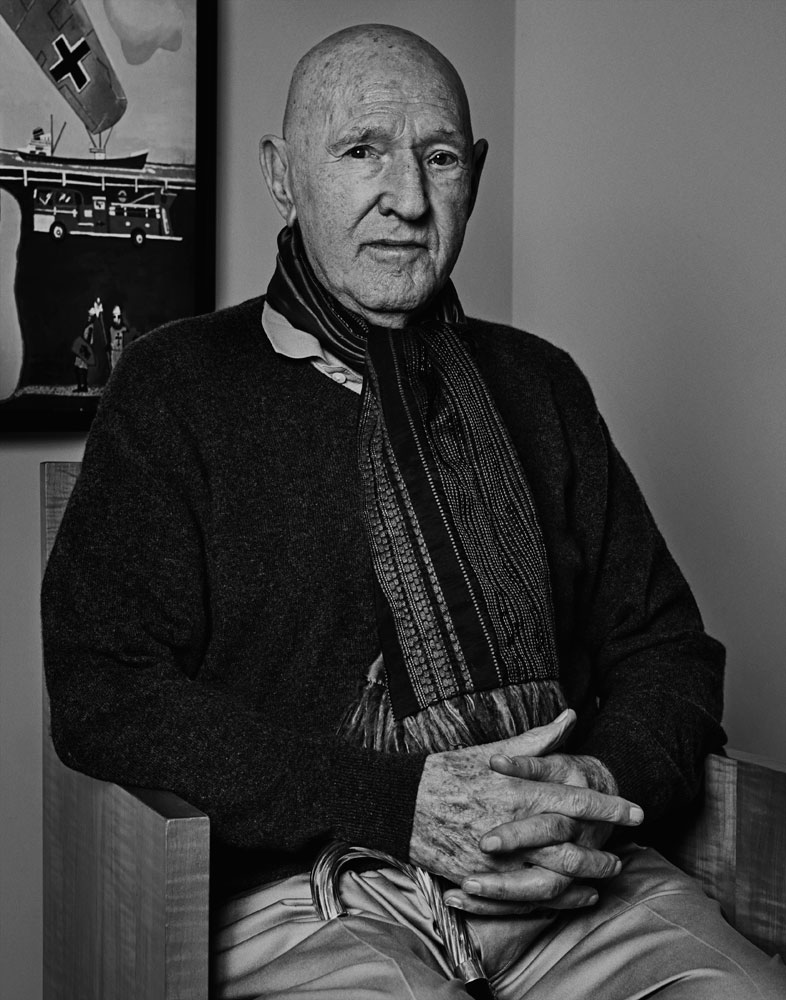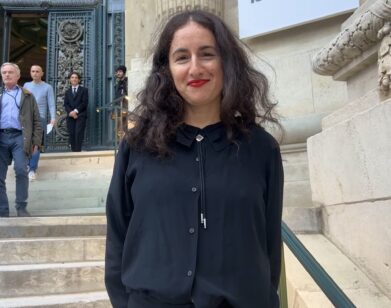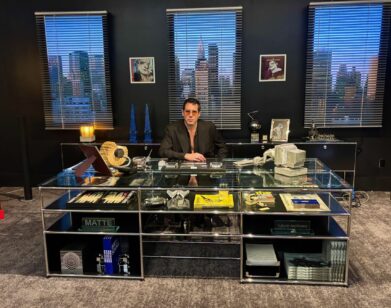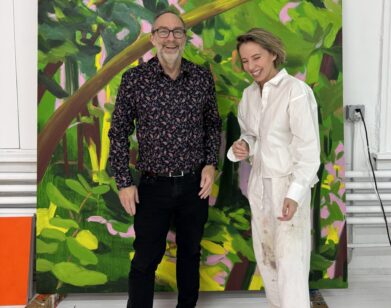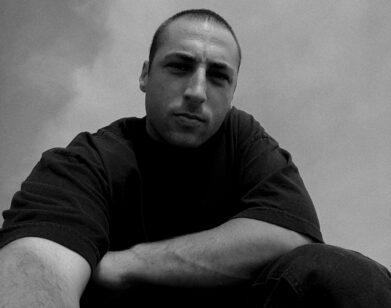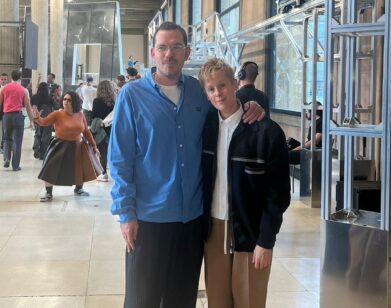Malcolm Morley and the Self
MALCOLM MORLEY IN NEW YORK, MARCH 2015. PORTRAITS BY CHRISTIAN HÖGSTEDT.
Transitioning between various mediums and styles since he began painting in the 1960s, New York-based artist Malcolm Morley’s most recent body of work explores his chosen iconography through sculptures made of paper and oil paintings on linen. The 15 new pieces, which are now on view at Sperone Westwater in New York, expand upon motifs previously seen in Morley’s work—fighter planes, Viking ships, lighthouses, medieval castles, and more—through surrealistic compositions created with the vibrancy of pop imagery. One might be led to believe that his childhood in London amidst the tumultuous years of World War II is the root of such subject matter, however, upon speaking to Morley, it becomes clear that his source material is much simpler: an ever-growing, yet relatively untouched stack of model airplanes, castles, trains, and other various objects, unassembled, still in their original boxes.
For the last 30 years, Morley has collected model sets, but it wasn’t until now, inspired by Comte de Lautreamont’s image of a “chance meeting on a dissection table of a sewing machine and an umbrella” in his 19th-century poetic novel Les Chants de Maldoror, that he put the collection to use. In the works, Morley often depicts many of the unmade objects through paint, although he also built a few of the models, psychically imposing them upon the surface, bringing the two-dimensional forward, into the viewer’s space.
When Morley moved from London to New York in 1958, he was painting with an abstract expressionist aesthetic, but soon adopted—and arguably caused the creation of the term—photo-realism. Despite leading this painterly movement, Morley does not consider his older works photo-realistic, instead preferring the term “super-realism.” He has since dabbled in other movements and styles, including sublime watercolors, and exhibited solo shows around the world at establishments that include the Pompidou in Paris, Hayward Gallery in London, the Museum of Contemporary Art in Miami, and the Parrish Art Museum just outside of New York City.
Before the opening of “Malcolm Morley,” we met the artist and spoke about everything from the exhibition to his experience with psychoanalysis, dreams, and alter egos.
EMILY MCDERMOTT: For the most recent works, it’s a lot of war imagery, like planes, castles, and trains. There are all sorts of recurring elements. When did you first begin this new series and what sparked it?
MALCOLM MORLEY: First, I don’t think of them as series, because I have no idea after one painting what painting comes next, so it surprises me. Over the years I’ve collected a stack of model ships that come in cardboard packages with instructions on how to construct it. They were sitting on a shelf for years without me doing anything much about it, but as of late, I’ve gone to use what’s available in the stack.
They’re three-dimensional objects that I look at, and the emphasis is very much on the idea of looking at. I paint them from the way in which I’m looking at them, which is really from the point of view of sensations. I feel the sensation of it, and pre-imagine it made of paint. As an exercise, whatever is in front of you, you can imagine what it would look as paint. This is determined by the amount of references you have already to how paint looks; it’s an accumulation of experiences that enrich the current sensation, [like] looking at that glass of water, not as a glass of water, but as paint on a two-dimensional surface. So it’s not just a question of looking, but of doing, in relation to this, in relation to that, in relation to the space between things. In a way, it’s very classical.
MCDERMOTT: Do you consider painting everything you see?
MORLEY: No, it has to be specific. Lately it’s become iconic. What I’m painting right now is a Trojan horse, which is from a kit. So I have this actual horse, which is very realistic, made of cardboard, and I place it, and I paint it.
MCDERMOTT: How do you determine what you want to make three-dimensional?
MORLEY: I want to say it’s a question of time, in the sense that I have hundreds of these things and only picked a couple. But the way in which the painting gets constructed is that I paint one single object and see what it suggests as a second object. In this case, I paint the fighter bunk first, and then the lighthouse.
It comes from an influence of a writer called Lautréamont, who wrote a famous book called [Les Chants de] Maldoror and it became the mantra for the surrealists. In it was the statement of a sewing machine with an umbrella on a dissecting table. For me, I picked up on that in so much that sewing machine doesn’t relate to an umbrella on a dissecting table, but when all three of them are together, that’s the relationship. That was really helpful to me to go about how the paintings add on. He was a very young man, this Lautréamont. He died at the age of 24 and had written this book, and a couple of other books, that became classics. It’s a very cruel, nasty book.
MCDERMOTT: When did you first come across it?
MORLEY: I’ve had the book itself without reading it for years. But I have a friend, who is also a mentor, who lives in Paris, Jean-Claude Lebensztejn, he was telling me about Maldoror. [It’s] hard reading. For example, there’s one part where he’s talking about a cat that jumps on his neck and wants to injure him, and you realize that he drowned the cat’s kittens in boiling oil. It really was founded of the theater of cruelty.
MCDERMOTT: I know reading about other artists is something you often do. The first thing that really brought you to art was Lust for Life, the book on Van Gogh, so it’s interesting to see that idea of violence still coming through.
MORLEY: Well, when I was a young man, I was actually in jail, as you probably know. I think that’s one of the books that came through then. It was a perfect setting to read it… There were reproductions in this book, and whatever idea I had about art had been from my grandmother, who’s idea of an important artist is somebody who is an RA—a Royal Academy admission—with very slick finishes, something that would be very hard to do. So when I looked at the Van Gogh, it seemed that it was something I could do, because they were crude. There was something about it that was very primal.
MCDERMOTT: I know some other artists you admire are Cézanne and Vermeer, but their styles are so different. How did you become interested in them?
MORLEY: I very soon caught onto the idea that there’s a progression in painting, that it progresses. Not that it necessarily gets better or worse, but it changes and what changed with Cézanne was an enormous step for moving away from linear perspective into painting from sensations.
MCDERMOTT: Which is what you do.
MORLEY: Right, so it seemed to be a step forward. Cézanne was definitely the man, but before that there was Manet, and one of my most favorite painters is Velásquez, who still is involved with the idea of the world as paint.
When you look at Velásquez, they look like [globs] that he’s flicked on the canvas, and you stand back, it’s this astonishing diamond. It’s from that family of painterly-ness that has been a base, but the recent developments have been much more involved with an idea of subject matter, such as the Trojan horses, or, the last painting that I made was the Alamo. It’s the last painting and it’s an American icon.
These were a bunch of Texans that had revolted against the Mexicans, because they were in Mexico. That was Mexican, the Alamo, but it allows me to think about Davy Crockett, Jim Bowie, and what happened to them.
MCDERMOTT: You reference the war in Britain and Greek history, but now you’re also referencing American history. How do you balance the difference?
MORLEY: It wasn’t as American history; I wanted to bring in these images made from these kits, so that’s the actual stimuli. What affected me a great deal as a boy was World War II; there were air raids and things like that. I’m very much a child of World War II.
MCDERMOTT: I’ve read that a lot of articles that refer to you as a British-born American artist, which I find interesting given the often British subject matter and the fact you were raised in England. What do you make of that label?
MORLEY: I don’t consider myself, period.
MCDERMOTT: You don’t consider yourself, ever?
MORLEY: No, but the idea of the self interests me a great deal. What is the self? And finding yourself, and which self? In a way, we’re more than one self, but you somehow try to get to a rock bottom self.
MCDERMOTT: I know you’ve done a lot of psychoanalysis. Is that all to find the self?
MORLEY: Very much so. One of the things is making friends with your unconscious life. That’s a great source of energy.
MCDERMOTT: Would you consider yourself friends with your unconscious self? What have you discovered through that?
MORLEY: Yes, [and] intense dreaming—remembering dreams, writing them down.
MCDERMOTT: What did you dream last night?
MORLEY: Actually I didn’t remember dreaming last night. [laughs] I very often have dreams about alter egos, like Jasper Johns, who I am very fond of.
MCDERMOTT: You would consider Johns one of your alter egos?
MORLEY: Yes, I would.
MCDERMOTT: So what would you do if you lived in his shoes for a day?
MORLEY: [laughs] Well, what he’s been doing, recently, is painting Picasso paintings. It’s always going through my mind, and very often, it is, “What would Picasso do?”
MCDERMOTT: How long have you been doing psychoanalysis?
MORLEY: Forever, but I’ve stopped now, actually. My shrink threw me out. I had a dream about him. I forget what it was, but he said, “I think it’s time for you to leave.”
MCDERMOTT: And you haven’t tried to find another one? Do you want to?
MORLEY: No… [Psychoanalysis] comes down to the process itself—the self, and life. I think I can say that I’m friends with the unconscious life, but I’ve never tried to make a painting directly from a dream. The paintings have a lot to do with the idea of seeing and doing, and the relationship between your hand and your eye, and the object. Cézanne said that he felt his eye would bleed when he took it off of one spot and moved it over to the next piece. Isn’t that fantastic? Like his eyes are suction cups.
MCDERMOTT: It’s really discovering yourself, yet you said you don’t question or consider yourself.
MORLEY: In some areas, yes, I do. I’ve done a lot of bad things in the past, and that troubles me, so I keep going over that, for example. It is often before I could say I was a self.
MCDERMOTT: Do you want to talk about anything you did when you were younger?
MORLEY: [pauses…shakes head]
MCDERMOTT: You came to America in 1959, after the end of the war. What was it like working alongside all of the pop artists in New York?
MORLEY: It was wonderful. I became friends with Roy Lichtenstein and Ivan Karp. Ivan Karp had worked with Leo Castelli and was the person who brought the pop art thing into being. He discovered Andy Warhol, [James] Rosenquist, and I met all of those guys, but they were a little bit before me. When I first came over here I was doing abstract expressionist paintings, but that didn’t feel right.
MCDERMOTT: That’s when you adopted photo-realism, or “super-realism.”
MORLEY: I’ve been campaigning that the earlier paintings are paintings, not photographs, but when you see them in reproduction, they look like a photograph. At a dentist office, they stay on the page, whereas a Picasso painting looks like a painting [in a photo]. My whole thing was to make a painting that didn’t look like a painting [from far away or in reproduction], although when you look at the surface, they’re very painterly. And that was the hidden…
MCDERMOTT: Subtext. What brought you away from photo-realism?
MORLEY: By the end of the year, there were 100 guys doing this. One was specializing in racehorses, another one was doing diners. I felt pushed from behind. They used airbrushes, and critics were saying, “When you look at a Morley, they’re quite ugly. The brush strokes are ugly.”
In a sense, the painting that pushed me over the edge was the painting of the South African racetrack. I made the painting of the racetrack from a poster. I had gone to see a film that night, this political film about the Greek colonel and he gets assassinated. [I was] so mad when we came back from the movie, I went down to my studio and put an X on the racetrack. It became “Malcolm’s X;” it was a pun that I couldn’t have invented—talk about three tiers of the unconscious. That’s how this X became a very famous painting, how this X got on the racetrack! And that was pushing me away. It was apartheid as well as anti-photorealism in one shot. When I experienced the power of unconscious life and going with it, it was a great revelation.
MCDERMOTT: Your painting and work on a whole have gone through so many changes. Would you say you have a philosophy toward art?
MORLEY: It’s a great means of self-discovery. One of the things that appealed to me in the beginning was that it was a great way to get girlfriends. [laughs] Girls seemed to like artists! I felt very drawn to the idea of power, really, and doing painting as a power trip, in a sense. This idea of power has always driven me.
MCDERMOTT: To this day?
MORLEY: To this day, to this second. And, will.
MALCOLM MORLEY IS ON VIEW AT SPERONE WESTWATER IN NEW YORK THROUGH JUNE 6.

